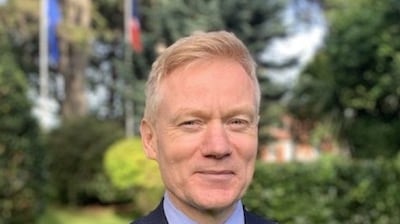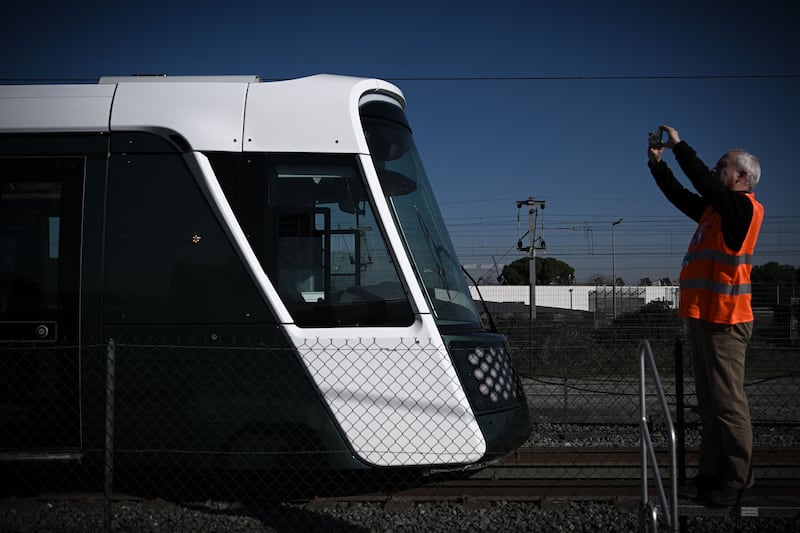However you quantify it, trade and investment between France and Ireland are going gangbusters. Ireland’s Central Statistics Office and the Douane Française have different ways of calculating statistics but both show significant increases in recent years.
Ireland reported €30 billion in trade in goods and services between the two countries in 2022. Vincent Guérend, France’s ambassador to Dublin, cites the French figure of €16 billion for commerce in goods only. Franco-Irish trade is comparable to that between France and much larger economies such as Brazil and Japan.
Patrick Torrekens, the head of Enterprise Ireland in Paris, says the small and medium-size Irish companies he represents increased exports to France by 27 per cent last year. Bord Bia, the Irish Food Board, reported a 31 per cent increase to €1.1 billion. Growth in beef exports was particularly strong, at €323 million, a 56 per cent increase.
Guérend says French exports to Ireland grew by 45 per cent in 2022, essentially from the sale of Airbus aircraft and chemical and pharmaceutical products. The Irish Government purchased three Airbus aircraft to facilitate the rescue of Irish citizens in crises such as those in Afghanistan and Sudan.
READ MORE
Contrasting assessments of the balance of payments are in part due to the way one counts the leasing of aircraft purchased in France by Ireland, then leased back to France. This has created a quirky situation where both countries believe they have a trade deficit with the other. Ireland evaluates its trade deficit with French to be €4.9 billion, while France believes it has a €3.74 billion deficit with Ireland.
Chemicals and pharmaceutical goods account for the largest portion of trade in both directions, accounting for 56 per cent of Irish goods exported to France. France tends to send pharmaceutical components to Ireland, while Ireland sends finished medicines in the other direction.
The French pharmaceutical giants Sanofi and Servier have a strong presence in Ireland. Sanofi employs 1,000 people at its Waterford factory, which has a €7 billion annual turnover. Servier maintains 450 jobs in Wicklow.

The Irish pharmaceutical companies Icon and Life Scientific operate in Lyon, where the French sector is concentrated. Icon is also present in Paris. Both support French companies with clinical research on product development and commercialisation, Torrekens says. Barclay Chemicals provides fertiliser and other products to improve French crops.
Smurfit Kappa’s 45 manufacturing plants and 6,000 employees in France generated more than €1.5 billion in revenue in 2022. The Irish company is the leading maker of corrugated packaging in France and ranks second in the world.
Torrekens has visited some of Smurfit Kappa’s French plants. “The reason they have so many is that they want to be close to their customers,” he says. “They are very focused on sustainability. It’s an innovative company that is highly respected, the flagship of the Irish economy here in France.”
The Irish subsidiary of the US consulting group Accenture is technically the largest Irish company in France, Guérend says. CRH, the building materials giant, follows Smurfit at number three, with 2,000 employees. Kingspan, the Co Cavan producer of insulation materials, is fourth.
Also among the Irish success stories in France is Paragon ID, which makes paper and digital ticketing for metros in Paris and regional cities. The Kerry Group, which celebrated 50 years in the French market last year, owns factories and R&D facilities. The low-carbon cement company Ecocem is one of seven Irish companies participating in the €35 billion Grand Paris project. The biggest building site in Europe will create four new metro lines, 200km of automated underground rail and 68 new train and metro stations, as well as linking the Roissy Charles de Gaulle and Orly airports.
Ireland enjoys a reputation for excellence in the construction of specialised buildings such as pharmaceutical labs and data centres. Mercury built an important data centre for the Interxion digital realty company in Paris. The PM group won a contract to build a lab for Sanofi.
“What strikes me is that very large French groups choose Irish companies,” says Torrekens. “An IT company called Origina was hired by [the world’s largest luxury goods company] LVMH to support its IT infrastructure. The Irish start-up Flipdish found a solution for Galeries Lafayette to deliver high-standard gourmet food across France.”
Characteristics of French companies in Ireland and Irish companies in France reflect their home economies, Guérend says. “Big French companies are bigger than big Irish companies.” In the services sector, the Société Générale and BNP-Paribas banks, Axa insurance and the investment fund Amundi, owned by Société Générale and Crédit Agricole, have large operations in Ireland.
Other big French companies in Ireland are the Danone food giant, with large factories in Wexford and Macroom, Co Cork, and St Gobain glass, with a factory in Ennis, Co Clare. The Valeo automotive-parts company employs 500 people at its factory in Tuam, Co Galway to produce cameras that equip luxury cars including Mercedes, BMW and Tesla.
Business strategies reflect the sizes of companies. “Irish companies typically choose partnership to enter the French market,” says Torrekens. “That is one way to get over the language barrier ... The French do not adopt that model because they have more multinational companies. Smaller French companies will also look for an Irish partner.”
The establishment of 40 double-degree programmes, where young people earn diplomas from both an Irish and a French business school, as well as placement programmes for young graduates by Irish and French semistate bodies, are creating a new generation of Franco-Irish entrepreneurs who speak each other’s language.
The Irish Embassy in Paris has 900 young people who aspire to succeed in French business registered in its careers network.
“That’s a real sign of dynamism for the future,” says an official. “You can be proud of the next generation of Irish people who are coming through.”
The Celtic Interconnector and Alstom’s contract with Irish Rail are exceptionally large, headline-grabbing Franco-Irish projects.

The Interconnector, described by an executive at EirGrid as “essentially an offshore wind farm in the middle of the Celtic Sea with an electricity cable linking the two jurisdictions” is scheduled for completion in 2026, at an estimated cost of €1.6 billion. It will provide 700 megawatts of electricity moving in both directions between Ireland and France – enough to power 450,000 homes – and marks Ireland’s entry to the continental electricity market.
Alstom’s €1.1 billion contract with Irish Rail will provide 750 electric or battery-powered train carriages over the next decade and constitutes the largest, most sustainable fleet to date for the Irish public transport network.
The Interconnector and Alstom projects are in a way outside normal trade but are considered crucial infrastructure. “One of our arguments is that when you have these big structural projects, you can spin off a lot of other areas of trade from that,” says the Irish official.
Brexit led to a fourfold increase in the weekly number of direct ferry crossings between France and Ireland, from 12 to 44.
“It has changed the way people think about France,” says the official. “Before, goods were going to distribution centres and warehouses in Liverpool and Manchester for pre-stocking in the UK before onward shipment to Ireland. That’s not happening any more ... Irish companies are saying, ‘There are 60 million people on our doorstep. Why are we going to the Netherlands and Germany and not going to France as well?’”
Guérend says the increased number of transport links encourage businesses who need a fast, reliable route. “We see a lot more French businesses interested in the Irish market and vice versa, because they know their merchandise will travel faster and with less hassle,” the ambassador says.





















